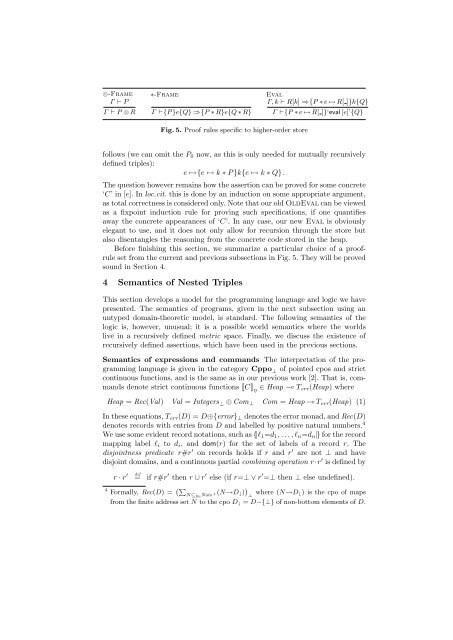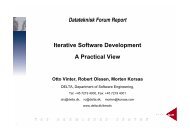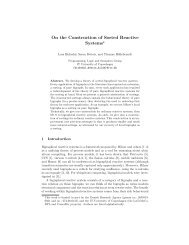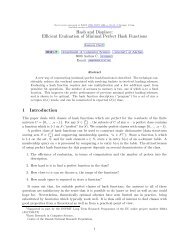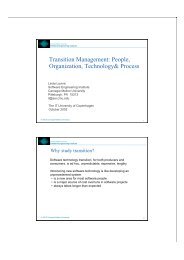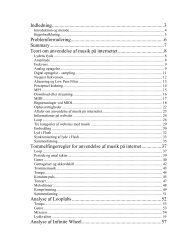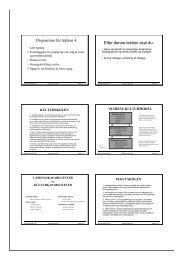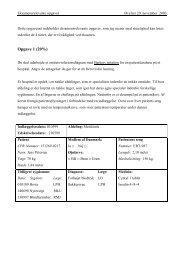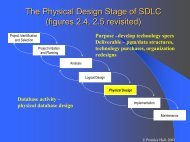Nested Hoare Triples and Frame Rules for Higher-order Store
Nested Hoare Triples and Frame Rules for Higher-order Store
Nested Hoare Triples and Frame Rules for Higher-order Store
You also want an ePaper? Increase the reach of your titles
YUMPU automatically turns print PDFs into web optimized ePapers that Google loves.
⊗-<strong>Frame</strong>Γ ⊢ PΓ ⊢ P ⊗ R∗-<strong>Frame</strong>Γ ⊢{P }e{Q} ⇒{P ∗ R}e{Q ∗ R}EvalΓ, k ⊢ R[k] ⇒{P ∗ e ↦→ R[ ]}k{Q}Γ ⊢{P ∗ e ↦→ R[ ]}‘eval [e]’{Q}Fig. 5. Proof rules specific to higher-<strong>order</strong> storefollows (we can omit the P 0 now, as this is only needed <strong>for</strong> mutually recursivelydefined triples):e ↦→{e ↦→ k ∗ P }k{e ↦→ k ∗ Q}.The question however remains how the assertion can be proved <strong>for</strong> some concrete‘C’ in [e]. In loc.cit. this is done by an induction on some appropriate argument,as total correctness is considered only. Note that our old OldEval can be viewedas a fixpoint induction rule <strong>for</strong> proving such specifications, if one quantifiesaway the concrete appearances of ‘C’. In any case, our new Eval is obviouslyelegant to use, <strong>and</strong> it does not only allow <strong>for</strong> recursion through the store butalso disentangles the reasoning from the concrete code stored in the heap.Be<strong>for</strong>e finishing this section, we summarize a particular choice of a proofruleset from the current <strong>and</strong> previous subsections in Fig. 5. They will be provedsound in Section 4.4 Semantics of <strong>Nested</strong> <strong>Triples</strong>This section develops a model <strong>for</strong> the programming language <strong>and</strong> logic we havepresented. The semantics of programs, given in the next subsection using anuntyped domain-theoretic model, is st<strong>and</strong>ard. The following semantics of thelogic is, however, unusual; it is a possible world semantics where the worldslive in a recursively defined metric space. Finally, we discuss the existence ofrecursively defined assertions, which have been used in the previous sections.Semantics of expressions <strong>and</strong> comm<strong>and</strong>s The interpretation of the programminglanguage is given in the category Cppo ⊥ of pointed cpos <strong>and</strong> strictcontinuous functions, <strong>and</strong> is the same as in our previous work [2]. That is, comm<strong>and</strong>sdenote strict continuous functions C η∈ Heap ⊸ T err (Heap) whereHeap = Rec(Val) Val = Integers ⊥ ⊕ Com ⊥ Com = Heap ⊸ T err (Heap) (1)In these equations, T err (D) = D⊕{error} ⊥ denotes the error monad, <strong>and</strong> Rec(D)denotes records with entries from D <strong>and</strong> labelled by positive natural numbers. 4We use some evident record notations, such as {|l 1 =d 1 , . . . , l n =d n |} <strong>for</strong> the recordmapping label l i to d i , <strong>and</strong> dom(r) <strong>for</strong> the set of labels of a record r. Thedisjointness predicate r#r ′ on records holds if r <strong>and</strong> r ′ are not ⊥ <strong>and</strong> havedisjoint domains, <strong>and</strong> a continuous partial combining operation r·r ′ is defined byr · r ′ def= if r#r ′ then r ∪ r ′ else (if r=⊥ ∨ r ′ =⊥ then ⊥ else undefined).4 Formally, Rec(D) = `P N⊆ fin Nats(N→D + ↓ )´where (N→D ⊥↓) is the cpo of mapsfrom the finite address set N to the cpo D ↓ = D−{⊥} of non-bottom elements of D.


